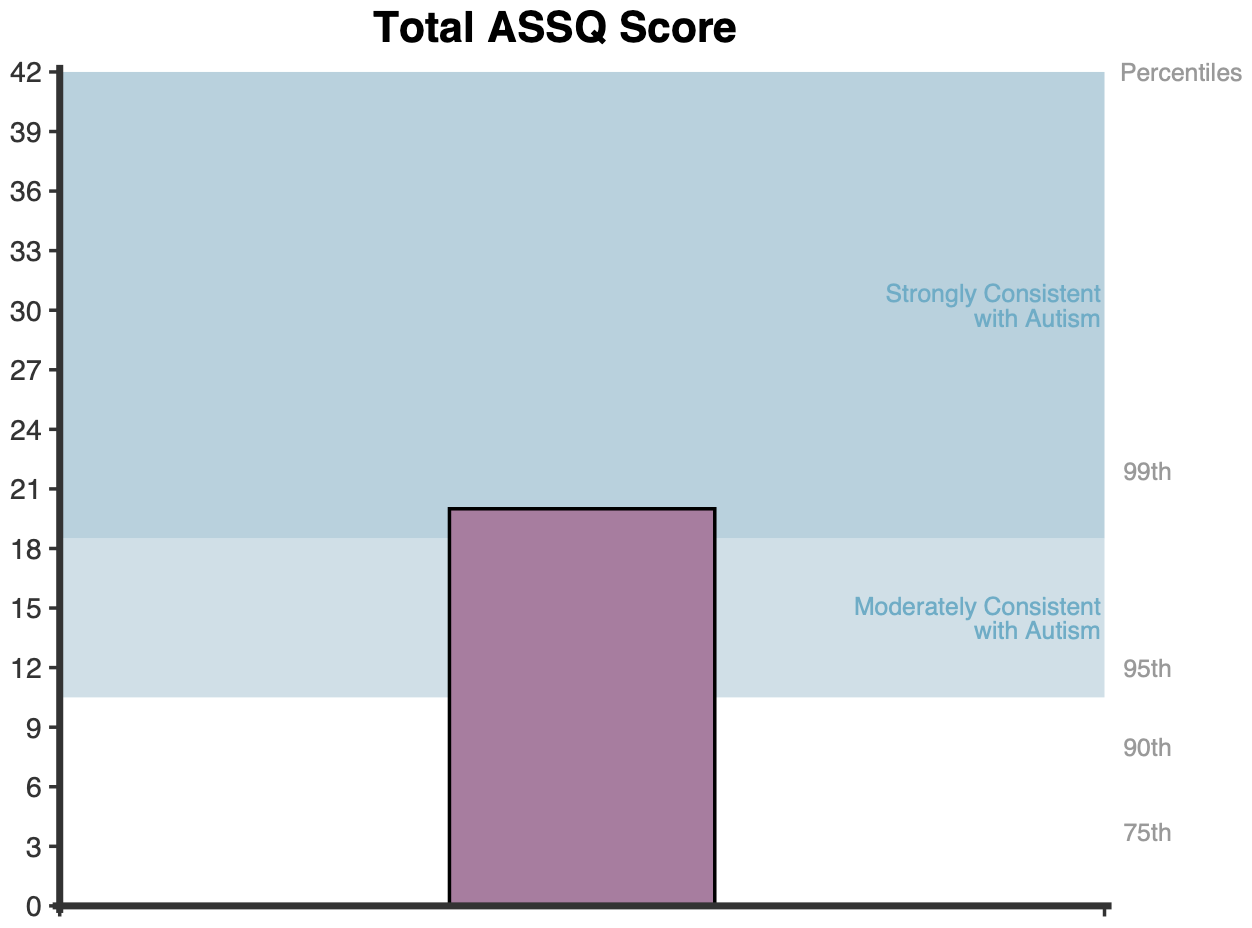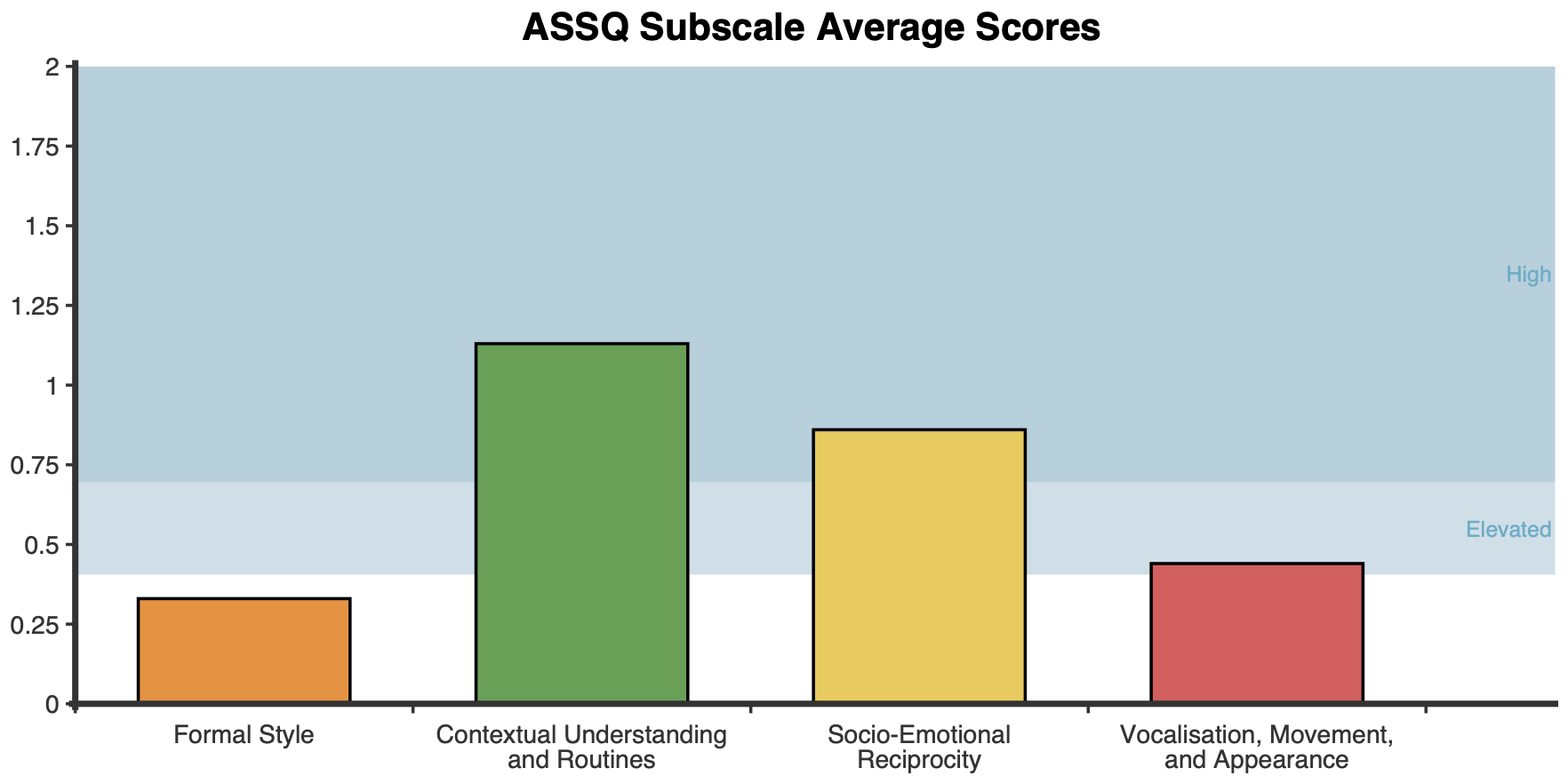The Autism Spectrum Screening Questionnaire (ASSQ) is a screening tool designed to identify young people who show developmental differences in social and behavioural functioning (Ehlers et al., 1993, 1999). Parents/Guardians or teachers answer questions about the young person’s traits and behaviours to provide insights into their developmental profile.
The Autism Spectrum Screening Questionnaire (ASSQ) is a 27-item parent- or teacher-rated screening tool designed to identify young people between 6 and 17 years of age who show developmental differences in social and behavioural functioning consistent with Autism (Ehlers et al., 1993, 1999).
The ASSQ assesses four distinct domains, informed by a recent factor analysis (Junttila et al., 2023):
Validation studies have demonstrated the ASSQ’s ability to distinguish between Autistic young people, those with other neurodevelopmental or psychological conditions (e.g., ADHD), and neurotypical young people (Ehlers et al., 1999).
Scores are interpreted using established thresholds and normative data for both general and Autistic populations, with informant-specific percentiles providing additional context (Ehlers et al., 1999; Posserud et al., 2006).
The ASSQ is intended for use by qualified professionals, such as psychologists, as part of a comprehensive assessment process. It should not be used as the sole means for diagnosis.
The Autism Spectrum Screening Questionnaire (ASSQ) yields a total score between 0 and 54, with higher scores indicating greater differences in social and behavioural functioning from other young people.
The total ASSQ score is expressed as a community percentile based on normative data for young people in the general population (Posserud et al., 2006) and as a clinical percentile based on data for Autistic young people (Ehlers et al., 1999). These percentiles are informant-specific, derived from either parent- or teacher-rated ASSQ data. When the informant type is “Other” or unknown, percentiles derived from parent-rated ASSQ data are used. The percentiles contextualise the young person’s score relative to the typical scores of young people overall and Autistic young people specifically.

The scoring approach uses established cut-off scores to categorise the young person’s score as either “Moderately Consistent with Autism” or “Strongly Consistent with Autism” (Ehlers et al., 1999).

Scores are also provided for the four factors (subscales) identified by Junttila and colleagues (2023):
The average score for each subscale is calculated by dividing the subscale’s score by the number of items in the subscale, which standardises the scores and enables direct comparisons between subscales. A higher average score suggests that the young person shows greater differences in a particular area compared to other areas. Clients assessed on NovoPsych typically score highest on the Contextual Understanding and Routines subscale and the Socio-Emotional Reciprocity subscale, followed by the Vocalisation, Movement, and Appearance subscale, and lowest on the Formal Style subscale.

The scoring approach also uses qualitative descriptors to categorise ASSQ subscale scores based on average score thresholds that correspond to the total ASSQ cut-off scores. These thresholds are calculated by dividing the total cut-off scores by the number of items in the scale (i.e., 27). Specifically:
These thresholds are used to categorise the average score for each subscale as follows.

Graphs are presented showing the young person’s total ASSQ score and the young person’s average score for each subscale. A graph is also presented comparing the young person’s total ASSQ score to the normative distribution of scores among Autistic young people and young people in the general population, with shaded areas corresponding to scores between the 25th and 75th percentile (Ehlers et al., 1999; Posserud et al., 2006). This graph contextualises the young person’s score relative to the typical scores of Autistic young people and young people overall.

The 27-item Autism Spectrum Screening Questionnaire (ASSQ) demonstrates strong reliability and validity as a screening tool for Autism in young people (Ehlers et al., 1999). Reliability evidence includes high test-retest reliability over both 2-week interval (r = .96 for parent ratings) and an 8-month interval (r = .90 for teacher ratings), as well as good inter-rater reliability between teachers (r = .79), suggesting stability of scores over time and across raters.
Convergent validity is demonstrated by strong correlations with the Rutter scales, which assess general emotional and behavioural symptoms (r = 0.75 for parent ratings and r = 0.77 for teacher ratings). Criterion validity is supported by the ASSQ’s ability to discriminate between Autistic young people, those with other neurodevelopmental or psychological conditions, such as ADHD, and neurotypical young people.
The ASSQ was designed to be completed by different informants, including parents and teachers, with different cut-off scores recommended for each type of informant. Ehlers and colleagues (1999) proposed the following cut-off scores:
For consistency and interpretability, NovoPsych uses the lower of the two cut-off scores for each category — 11 as the “Moderately Consistent with Autism” cut-off score and 19 as the “Strongly Consistent with Autism” cut-off score — regardless of the informant. This conservative approach prioritises identifying young people who may benefit from further, comprehensive assessment for Autism or other (neuro)developmental differences.
Confirmatory factor analysis of 37,036 ASSQ responses on NovoPsych validated a four-factor structure proposed by Junttila and colleagues (2023), which demonstrated the best model fit among competing models (Baker et al., 2025). NovoPsych renamed these factors to enhance interpretability as follows:
The ASSQ was originally validated on two clinical samples (Ehlers et al., 1999). The main sample included 110 6- to 17-year-olds (87 boys and 23 girls) with various (neuro)developmental differences. The other sample included 34 6- to 16-year-old boys diagnosed with Asperger’s Syndrome whose mean parent-rated and teacher-rated total ASSQ scores were 25.1 (SD = 7.3) and 26.4 (SD = 11.7), respectively. These scores were similar to those of the autism spectrum disorder group within the main sample. These means and standard deviations are used to convert the young person’s total ASSQ score to the presented clinical percentile, providing useful information about the young person’s level of social and behavioural functioning relative to Autistic young people.
Percentiles for the general population are from a study by Posserud, Lundervold, and Gillberg (2006, p. 170), which included 6,229 parent-rated and 9,149 teacher-rated ASSQs for 7- to 9-year old children attending all schools in Bergen, Norway in 2002. Their mean parent-rated and teacher-rated total ASSQ scores were 3.29 (SD = 4.49) and 1.99 (SD = 4.07), respectively. These percentiles are presented to contextualise the young person’s score relative to typical scores among young people in the general population, offering a clearer perspective on how the young person’s level of social and behavioural functioning compares to that of young people overall.
Ehlers, S., Gillberg, C., & Wing, L. (1999). A screening questionnaire for Asperger syndrome and other high-functioning autism spectrum disorders in school age children. Journal of Autism and Developmental Disorders, 29(2), 129-141. https://doi.org/10.1023/a:1023040610384
Baker, S., Smyth, C., Bartholomew, E., Buchanan, B., & Hegarty, D. (2025). A Review of the Clinical Utility and Psychometric Characteristics of the Autism Spectrum Screening Questionnaire (ASSQ): Percentile Rankings, Qualitative Descriptors, and Factor Structure.
Ehlers, S., & Gillberg, C. (1993). The epidemiology of Asperger syndrome. A total population study. Journal of Child Psychology and Psychiatry, and Allied Disciplines, 34(8), 1327-1350. https://doi.org/10.1111/j.1469-7610.1993.tb02094.x
Ehlers, S., Gillberg, C., & Wing, L. (1999). A screening questionnaire for Asperger syndrome and other high-functioning autism spectrum disorders in school age children. Journal of Autism and Developmental Disorders, 29(2), 129-141. https://doi.org/10.1023/a:1023040610384
Junttila, M., Jussila, K., Joskitt, L., Ebeling, H., Kielinen, M., Loukusa, S., Miettunen, J., Mäntymaa, M., & Mattila, M. L. (2023). Factor analysis of the autism spectrum screening questionnaire in a population-based child sample. Nordic Journal of Psychiatry, 77(7), 696–705. https://doi.org/10.1080/08039488.2023.2225060
Posserud, M. B., Lundervold, A. J., & Gillberg, C. (2006). Autistic features in a total population of 7-9-year-old children assessed by the ASSQ (Autism Spectrum Screening Questionnaire). Journal of Child Psychology and Psychiatry, and Allied Disciplines, 47(2), 167-175. https://doi.org/10.1111/j.1469-7610.2005.01462.x
Posserud, B., Lundervold, A. J., Steijnen, M. C., Verhoeven, S., Stormark, K. M., & Gillberg, C. (2008). Factor analysis of the Autism Spectrum Screening Questionnaire. Autism, 12(1), 99-112. https://doi.org/10.1177/1362361307085268
NovoPsych’s mission is to help mental health services use psychometric science to improve client outcomes.
© 2023 Copyright – NovoPsych – All rights reserved